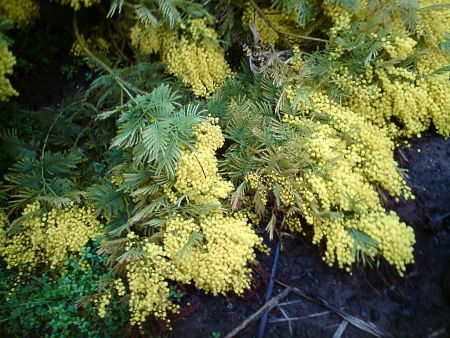The "mimosa" as we know it
/We call this a mimosa but it’s really the silk tree. — Jeff Heard/Creative Commons
Blooming now along roadsides, in vacant city lots and in some backyards is a distinctive, small tree — umbrella-shaped, with ferny leaves and flowers like pink powder puffs perched atop its branches.
Ask someone what it is and they will probably tell you it’s a mimosa, since that is the commonest of its common names in the United States. In another one of those taxonomic boggles for which horticultural nomenclature is famous, this tree once found a home, briefly, in the mimosa genus, but it was long ago evicted.
The tree is properly Albizia julibrissin, or silk tree, if you will. The genus memorializes the Italian nobleman Filippo del Albizzi, who brought it to Europe in the mid-18th century from its native haunts in southeastern Asia (from Iran east to China and Korea). The species name is a corruption of a Persian word meaning “silk flower,” and those pom-pom flowers do look like a cluster of silky threads.
Since the tree arrived in the United States in 1745, it has aroused strong feelings, pro and con.
Some people think it is a perfectly nice ornamental and profess a certain nostalgic fondness for it. Those who fret about the wanton spread of exotic plants disparage it as an unwelcome invader. It has made the hit list of federal invasive species organizations and is named among the “least wanted” by the Plant Conservation Alliance’s Alien Plant Working Group.
That’s a lot of emotion for a small and weak-limbed tree to bear.
By now, the silk tree has insinuated itself into disturbed habitats from southern New England west to Missouri and Illinois and south to Florida and Texas. What gives it an edge over natives is its rapid growth, its ability to resprout when cut down and its prodigious seed production.
The silk tree is a member of the pea family, a relationship that becomes clear when the long, pea-like seed pods appear sometime around August or September. A single tree can produce 200,000 seeds annually, and these both survive immersion in water and remain viable on land for a good 50 years.
The silk tree is hard to dislodge once it becomes established, which makes planting one an occasion for deliberate thought and no small caution. The chief weapons in any effort to get rid of it are herbicide and girdling the trunk, with rigorous follow-up on those seedpods and resprouting roots.
The real mimosa, a tropical tree. — cercamon/Creative Commons
People who love this tree claim it makes a showy little patio tree, but even its fondest fans can't entirely ignore its bad traits.
The branching trunks are weak and prone to breakage, the fallen pods are messy and the roots can dislocate walks and patio pavers as they grow thicker. Add its susceptibility to pests like webworm and diseases like the fatal mimosa vascular wilt, and the bad points outweigh the good. At best, it's a short-lived oddity; at worst, it's a hostile takeover in the making.
There are attractive native alternatives that don't carry such baggage. These include the serviceberry (Amelanchier arborea), the redbud (Cercis canadensis), flowering dogwood (Cornus florida) and the fringe tree (Chionanthus virginicus). By all means, consider one of these instead.
The true mimosas — some 400 species of herbs and shrubs — are subtropicals and tropicals found wild in Mexico, Uruguay, Brazil and Asia and grown indoors elsewhere. They bear yellow flowers much loved by florists and traditionally presented to women on International Women's Day (March 8) in some places.
The most interesting member of the clan is Mimosa pudica, or the sensitive plant, grown for its curiosity value. Once touched, the leaves are capable of rapid movement, closing up before your eyes as a Venus flytrap might.
Technically, this is known as nyctinastic or seismonastic movement — terms you can throw around at your next garden club meeting or cocktail party. It results from a rapid loss of pressure in strategically located cells that cause the leaves to droop while you watch.
I once encountered this plant at the Well-Sweep Herb Farm in Port Murray, NJ. I'm not especially proud of this: I was all but nudging visiting children out of the way so I might play with this interactive plant.
The tree we know as "mimosa?" Having inherited a pair of them at my first house, I know their downsides too well. Those, I can leave alone.


